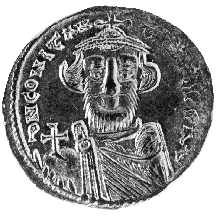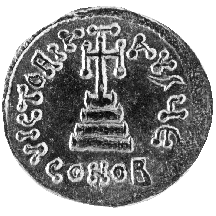



(136) Constans II - AV solidus, A.D. 647-651, 4.38 g. (inv. 91.276).
Obverse: Facing bust of Constans with short beard, wearing chlamys
and crown with cross, holding globus cruciger in r.; D(OMINVS) N(OSTER)
CONSTANTINVS P(ER)P(ETVVS) AV(GVSTVS): Our lord Constans, perpetual Augustus.
Reverse: Cross potent on four steps; VICTORIA AVGV(STI) E: Victory of the
Augustus, officina mark E; in exergue, CONOB: gold of Constantinople.
Provenance: Hesperia Art, 1959.
Bibliography: P. Grierson, Byzantine Coins (London 1982).
Constans II, the son of Heraclius Constantine and grandson of Heraclius
(see no. 135), was co-emperor with his uncle, Heraclonas, and became sole
emperor at the age of eleven when Heraclonas was deposed by the senate.
Although he is called Constantinus on his coins, Byzantine writers called
him Constans. In his reign the Arabs made inroads into Byzantine territory,
and anxiety over threats from the Lombards in Italy caused him to move to
Syracuse. He attempted without success to resolve theological and political
differences with the Western Church. He was murdered in A.D. 668.
Constans modelled his coins after those of his grandfather, Heraclius (see
no. 135), changing his portrait as he aged from beardless to wearing a short
beard, as here, and finally to wearing a long, full beard. He also retained
the cross potent on the steps on the reverse.
R.K.B.



All contents copyright (c) 1996.
Lawrence University
All rights reserved.